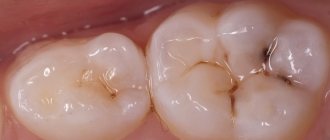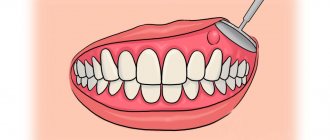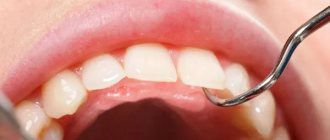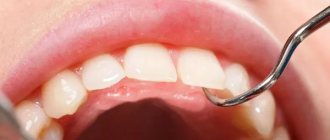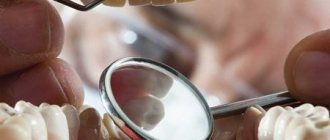Author of the article:
Soldatova Lyudmila Nikolaevna
Candidate of Medical Sciences, Professor of the Department of Clinical Dentistry of the St. Petersburg Medical and Social Institute, Chief Physician of the Alfa-Dent Dental Clinic, St. Petersburg
Medium caries is a stage of the carious process that occurs after the initial one and precedes the deep one. It is characterized not only by the destruction of enamel, but also by disruption of the dentin structure. Often the disease is practically asymptomatic, so the patient cannot independently identify the presence of this disease. The only method of self-diagnosis is to pay attention to changes in the appearance of the tooth when examining the oral cavity in a mirror (presence of holes) or to the appearance of sensitivity while eating.
If you look at a photo of average caries, you will notice pronounced changes in the structure and color of the affected area. Most often, the disease develops on the contact (chewing) part of the tooth. In the photo you can see dark brown or almost black spots, small or large holes, which can be located on any part of the tooth. These holes are a carious cavity in which dentin gradually softens and food debris accumulates.
With chronic average caries, the destruction of the enamel and dentinal layer occurs faster - carious cavities can appear as early as five months after the initial changes in the tooth enamel. Most often, young children suffer from the chronic form of the disease.
Causes of the disease
There are several factors that lead to the occurrence of this disease:
- Cariogenic microflora of the oral cavity.
- Increased carbohydrate content in the diet.
- Reduced resistance of hard tissues.
- Lack of oral hygiene.
- Malocclusion.
- Genetic predisposition to the disease.
- Plaque or tartar.
- Weakening of the immune system.
- Bleeding gums.
- Changes in the composition of saliva.
- Lack of calcium.
- Fluoride deficiency.
- Poor diet.
- Lack of vitamins.
- Abuse of carbonated drinks.
The main cause of average caries is late diagnosis of the disease at an early stage.
Prevention of acute caries and what it includes
Prevention of acute caries
In order to prevent the formation of caries, it is necessary to remember about prevention, which consists of the following aspects:
- You need to brush your teeth with sweeping movements twice a day, morning and evening, for about two minutes;
- You should rinse your mouth after every meal;
- nutrition should be balanced, special attention should be paid to products containing calcium and fluorine, vitamins C and D;
- Visiting the dentist is mandatory once every six months to detect tooth decay at an early stage and prevent it.
IMPORTANT: you cannot share the same toothbrush with another person, this can lead to the development of caries.
Symptoms of the disease
The disease can exclusively affect the upper layers of dentin. The process of development of medium-sized caries is accompanied by destruction of the enamel layer and a violation of the boundary between enamel and dentin. As a result, patients complain of the following unpleasant sensations:
- The presence of a carious cavity, which is easily detected using the tongue. In some cases, it may have sharp edges and cause injury.
- Food getting into the carious hole if it is located on the contact part of the tooth.
- Short-term painful sensations from exposure to hot or cold food, liquids, from the chewing process and from mechanical impact on the diseased tooth. Once the cause of the pain is eliminated, the unpleasant symptoms quickly disappear.
What complications can there be after treatment?
- Inflammation or even necrosis of the pulp - the tissue that fills the tooth cavity. Occurs after a long time due to inaccurate preparation of rotted tissue and excessive pressure on the pulp;
- secondary caries occurs due to the fact that during preparation some parts of the tissue affected by bacteria were not removed;
- inflammation of the gums due to injury;
- periodontitis, which occurs due to increased pressure on the tooth that occurs after the formation of an anatomically incorrect filling;
- loss of a filling due to insufficient strengthening or improper formation of a carious cavity.
Diagnosis of the disease
To prescribe effective treatment for the disease and exclude the presence of other diseases, it is necessary to diagnose secondary caries, which is carried out by the treating dentist.
In most cases, an experienced specialist only needs an instrumental examination to make a diagnosis. It is carried out using a probe and a mirror. As a result of the examination, a carious cavity is discovered, inside of which there is softened dentin. Mild pain is present only when probing the bottom of the cavity, since there are exposed nerve endings there. The walls of the carious cavity are insensitive.
During diagnosis, the doctor pays attention to the following factors:
- Density of the cavity bottom.
- Localization of the carious hole.
- The color of the damaged tooth.
- The presence and nature of pain in the patient during the study.
A soft bottom indicates moderate dental caries, and its density may indicate the presence of a wedge-shaped defect. The tooth becomes gray if the patient has developed chronic periodontitis. The short duration of painful sensations indicates superficial caries, and if the pain lasts longer than ten seconds, the disease has acquired a deep form.
If the affected area is in a hard-to-reach place, the doctor may prescribe an X-ray examination for the patient. In some cases, the dentist recommends undergoing electroodontic diagnostics or thermal testing.
Seals
Dental treatment and installation of a filling in Korolev is a labor-intensive process that requires high professionalism from the doctor so that it does not fall out untimely or break. In addition, the material from which the filling is made also affects the quality of treatment and the health of the tooth in general.
Fillings are needed for the treatment of caries, dental canals, wedge-shaped defects, as well as for the aesthetic restoration of damaged teeth.
A filling is a plastic and viscous medical material that gradually hardens in the tooth cavity on its own or under the influence of external factors. In our dentistry in Korolev, dental therapists use reflective fillings made from insoluble, safe and resistant materials that meet established hygienic standards.
Thanks to light fillings, restoration and treatment of anterior teeth can be carried out without difficulty. With this material you can easily and quickly sculpt a beautiful and correct shape, fixing the result with ultraviolet radiation.
Treatment of average caries
After diagnosis, it is necessary to urgently treat the disease to prevent the process from spreading to the deep layers of dentin. Otherwise, inflammation of the pulp may occur.
Treatment is carried out by preparing the damaged areas. It goes through several stages:
- The overhanging edges of the carious hole are carefully removed.
- Dentin, which has undergone a process of softening and pigmentation, is removed from the cavity.
- The bottom and walls of the damaged tooth are cleaned of the remains of destroyed tissue.
- A cavity is formed for subsequent filling.
During each stage, the dentist uses a specific type of bur, which differs in the shape and diameter of the tip. Preparation is carried out in bright light. At the end of this process, the cleaned cavity is treated with antiseptics, degreased, and then thoroughly dried.
The walls and bottom of the hole are coated with a special “glue”, and then the cavity is filled with filling material, which undergoes a curing process using chemical or light radiation.
The finished filling is corrected using diamond burs, as well as using various grinding discs, pastes and brushes. Correction can be made several times. The purpose of this procedure is to achieve maximum comfort in the patient when clenching the jaw. The restored surface should not cause even the slightest discomfort.
How is the treatment carried out?
During treatment, a drill is used and the dental nerve is affected, so it is impossible to do without anesthesia if you want to achieve high-quality treatment. If the nerve was once removed from the tooth, then you do not need to use an anesthetic.
Modern anesthetics are used as anesthesia - Ultracain, Septanest and other drugs with a similar effect.
Removal of infected tissue
Since patients turn to the dentist when caries has already penetrated not only into the enamel, but also into the dentin, it is necessary to remove tissue damaged by putrefactive processes in order to prevent the further spread of bacteria, as well as to form a cavity suitable for filling.
Modern technologies suggest replacing the drill with a laser, but this method is not characterized by reduced pain, and its cost is often unreasonably high, since laser tissue removal is not common in all clinics and is used extremely rarely.
After cleansing the caries-pigmented tissues, it is necessary to rinse the cavity and treat it with an antiseptic.
Treating the cavity with an antiseptic
Chlorhexidine or drugs with a similar effect are used as an antiseptic, which disinfect tooth tissue and reduce the activity of enzymes, which are a breeding ground for bacteria.
Dental nerve extraction
Removal of the dental nerve is indicated only in the case of a complicated form of acute caries, when destructive processes have already reached the nerve, exposing it. In this case, the patient experiences acute pain.
Now the removal of a nerve, both partial and complete, is most often completed in one visit to the dentist; the procedure is assisted by an X-ray machine, which allows you to evaluate the accuracy of the manipulation during the treatment process. Thanks to modern painkillers, there is no pain when the nerve is removed.
Restoration of the anatomical shape of the tooth
The last stage of restoring a tooth that has undergone caries is restoring its original shape. The materials used for this are composites, which are placed into the hole, and then ground and polished so that the finished filling does not cause any inconvenience to the patient, does not rub the cheek, does not injure the gums and tongue, and does not interfere with neighboring teeth.
For chewing teeth, which are subject to increased load, composites and ceramic inlays and onlays are used as cement. There are times when a doctor uses several types of material to restore the function and shape of a tooth.
Prognosis and consequences of the disease
Treatment of this disease, if the dentist has sufficient experience, is successful - all unpleasant sensations in the sealed cavity completely disappear, and the tooth again acquires aesthetic appeal. If an untreated area remains under the filling, the disease will progress further. For this reason, it is necessary to carefully consider the choice of clinic and attending physician.
If average caries is not treated in a timely manner, the disease will enter an advanced stage, which is fraught with severe pain, the development of pulpitis and periodontitis, and then tooth loss.
Superficial caries - caries in the upper layers of the tooth, in the enamel
Characterized by the presence of a small black or white cavity. Due to the fact that it is located superficially, it does not cause any discomfort or pain. Such caries, as well as caries in the spot stage, can only be identified during a preventive examination by a dentist. Treatment of such caries is completely painless, without even resorting to anesthesia. At this stage, minimal preparation and installation of a filling is already necessary. The cost of treating such caries will include a doctor’s examination and diagnosis, preparation of the carious cavity and installation of a filling.
The cost of a filling, in addition to its size, also depends on the need for aesthetic properties. Today there are a huge number of fillings that remain invisible to others. There are even chameleon fillings that change their color along with external lighting, and not even every dentist can see such a filling.
Accordingly, the cost of such fillings varies.
The cost of a filling for distant, chewing teeth, when there is no need for a special aesthetic appearance, starts from 300 rubles. for superficial caries, while the cost of modern highly aesthetic fillings, with the same cavity volume, starts from 850 rubles.
Thus, taking into account all the necessary manipulations, the average cost of treating superficial caries ranges from 700 to 1300 rubles.
Disease prevention
After each meal, food particles remain in the oral cavity, which contribute to the development of decay processes and create a favorable environment for bacteria. To prevent the spread of harmful microorganisms, it is necessary to brush your teeth regularly.
If a person has a tendency to develop the disease, the dentist prescribes special toothpastes that can reduce the risk of the disease. Thus, we recommend ASEPTA PLUS REMINERALIZATION paste, which strengthens the enamel and prevents caries on teeth.
Measures to prevent dental caries
The following preventive measures will help to avoid damage to the integrity of tooth enamel and damage to dentin:
- Regular (twice a year) visits to the dentist for a preventive examination.
- Thorough regular cleaning of teeth, interdental spaces, tongue using a toothbrush, paste, floss, and, if possible, an irrigator.
- Drinking drinking water rich in fluoride and other beneficial elements.
- Preventive intake of vitamin complexes as recommended by the dentist.
Prevention reduces the risk of dental caries and other dental diseases by more than 70%.
Clinical researches
Clinical studies have proven that regular use of professional toothpaste ASEPTA REMINERALIZATION improved the condition of the enamel by 64% and reduced tooth sensitivity by 66% after just 4 weeks.
Sources:
- Report on the determination/confirmation of the preventive properties of personal oral hygiene products “ASEPTA PLUS” Remineralization doctor-researcher A.A. Leontyev, head Department of Preventive Dentistry, Doctor of Medical Sciences, Professor S.B. Ulitovsky First St. Petersburg State Medical University named after. acad. I.P. Pavlova, Department of Preventive Dentistry
- Clinical experience in using the Asepta series of products Fuchs Elena Ivanovna Assistant of the Department of Therapeutic and Pediatric Dentistry State Budgetary Educational Institution of Higher Professional Education Ryazan State Medical University named after Academician I.P. Pavlova of the Ministry of Health and Social Development of the Russian Federation (GBOU VPO RyazSMU Ministry of Health and Social Development of Russia)
- Evaluation of the clinical effectiveness of a combined drug of local etiotropic action in the treatment of inflammatory periodontal diseases (E.L. Kalichkina, E.A. Tyo, Z.Z. Abubakarova) E.L. Kalichkina, candidate of medical sciences, assistant of the department of therapeutic dentistry, Kemerovo State Medical Academy of Roszdrav, Kemerovo E.A. Tyo, MD, professor, head of the department of therapeutic dentistry, Kemerovo State Medical Academy of Roszdrav, Kemerovo Abubakarova, assistant of the department of therapeutic dentistry, Kemerovo State Medical Academy of Roszdrav, Kemerovo GOU HPE Kemerovo State Medical Academy of Roszdrav , Kemerovo
Our prices
| Code no. | Name of procedures | Unit of measurement | Cost, rub. |
| 300 | Application anesthesia | 100,00 | |
| 301 | Infiltration anesthesia, conduction | 450,00 | |
| 303 | Treatment of medium caries (ultrasound, cavity formation) | 500,00 | |
| 304 | Treatment of deep caries (ultrasound, cavity formation) | 600,00 | |
| 305 | Placement of a light-composite filling (Esthet-X, Filtek) | 2 800,00 |
* The prices indicated on the website are not a public offer. The exact cost of treatment can only be determined at an appointment with a doctor.
Prices for treatment in Korolev full price list
Share on social media networks:
Article Expert:
Dyshekov Asker Mukhamedovich
Restorator, orthopedist. Treatment of caries and its complications. Dental restoration (restoration) using fiberglass and titanium pins. Aesthetic dentistry (teeth whitening ZOOM). Endodontic treatment of root canals using NI-TI instruments, retreatment of canals, preparation of teeth for orthopedic structures.
Work experience 10 years

